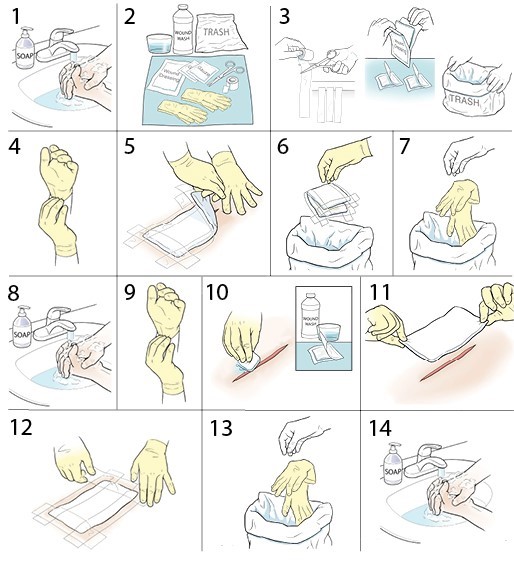A nurse is preparing to perform a wet-to-dry dressing change for a client who has an infected abdominal wound.
Which of the following techniques should the nurse use when performing this dressing change?
Remove the tape by pulling from the center of the dressing
Wear sterile gloves to remove the dressing
Clean the wound from the center to the outer edges
Moisten the dressing before removal
The Correct Answer is C
When removing the dressing and cleaning the wound, it is important to start from the center of the wound and work towards the outer edges. This technique helps prevent contamination of the wound by minimizing the risk of dragging bacteria or debris from the surrounding skin into the wound.
The other options listed are not recommended for this specific procedure:
When removing the tape, it is generally recommended to pull it parallel to the skin surface rather than pulling from the center of the dressing. This technique reduces the risk of causing trauma or disrupting the wound.
While it is important to maintain aseptic technique during dressing changes, wearing sterile gloves is not necessary for a wet-to-dry dressing change. Clean, non-sterile gloves are typically sufficient for this procedure, as the dressing material itself is not sterile.
In a wet-to-dry dressing change, the dressing is typically applied moist and allowed to dry over time. Therefore, moistening the dressing before removal is not necessary. The primary goal is to remove the dry dressing, which may adhere to the wound bed, and then clean the wound before applying a fresh dressing.

Nursing Test Bank
Naxlex Comprehensive Predictor Exams
Related Questions
Correct Answer is C
Explanation
Nausea and vomiting are common side effects of doxycycline, an antibiotic commonly used to treat chlamydial infections. Taking the medication with food or a snack can help alleviate these side effects. The recommendation to take the medication with crackers provides a light source of carbohydrates that can help settle the stomach and reduce nausea.
It is generally not recommended to take doxycycline with calcium-rich foods or beverages, as they can interfere with the absorption of the medication. Calcium can form complexes with doxycycline, reducing its effectiveness. Therefore, it is best to avoid calcium-rich foods and beverages, including calcium-fortified orange juice, when taking doxycycline.
Similar to calcium-rich foods, antacids can also interfere with the absorption of doxycycline. Antacids contain aluminum, magnesium, or calcium, which can bind to doxycycline and reduce its effectiveness. Therefore, it is generally recommended to avoid taking doxycycline with antacids.
While it is important to remain upright for a short period after taking some medications to prevent reflux or aspiration, this recommendation may not specifically address the client's nausea and vomiting. Taking the medication with food, such as crackers, may be more effective in alleviating the symptoms.
Correct Answer is B
Explanation
During an intravenous pyelogram (IVP), a contrast dye is injected into the client's veins, and X-ray images are taken to visualize the urinary tract. The dye used in an IVP can cause a warming or flushing sensation as it circulates through the body. The client's statement indicates an understanding of this common sensation associated with the procedure.
"I can have a meal up to 2 hours before the procedure": This statement is incorrect. Typically, for an IVP, the client is required to have an empty stomach before the procedure to ensure accurate imaging results. The client should follow the specific instructions provided by their healthcare provider regarding fasting before the procedure.
"I do not need to sign a consent form before this procedure": This statement is incorrect. Informed consent is required for most medical procedures, including an IVP. The client should sign a consent form after receiving all the necessary information about the procedure, its risks, and benefits.
"I should limit my fluid intake for 2 days after the procedure": This statement is incorrect. After an IVP, it is generally advised to increase fluid intake to help flush out the contrast dye from the body and prevent potential complications. The client should follow the specific instructions provided by their healthcare provider regarding post-procedure fluid intake.
Whether you are a student looking to ace your exams or a practicing nurse seeking to enhance your expertise , our nursing education contents will empower you with the confidence and competence to make a difference in the lives of patients and become a respected leader in the healthcare field.
Visit Naxlex, invest in your future and unlock endless possibilities with our unparalleled nursing education contents today
Report Wrong Answer on the Current Question
Do you disagree with the answer? If yes, what is your expected answer? Explain.
Kindly be descriptive with the issue you are facing.
